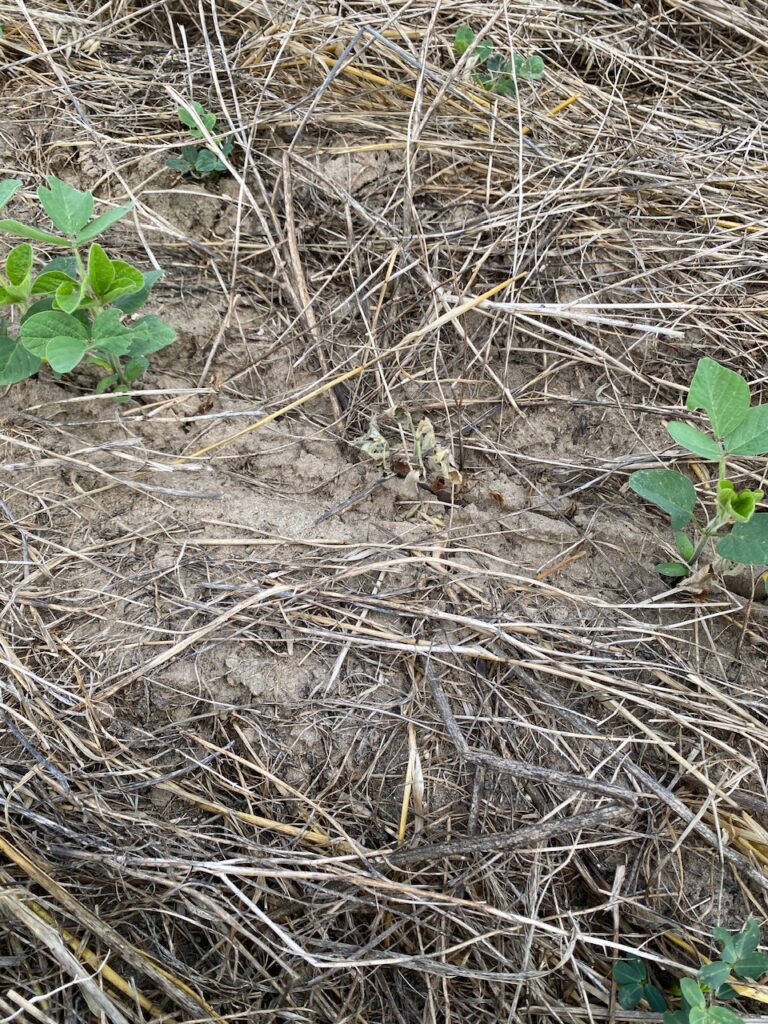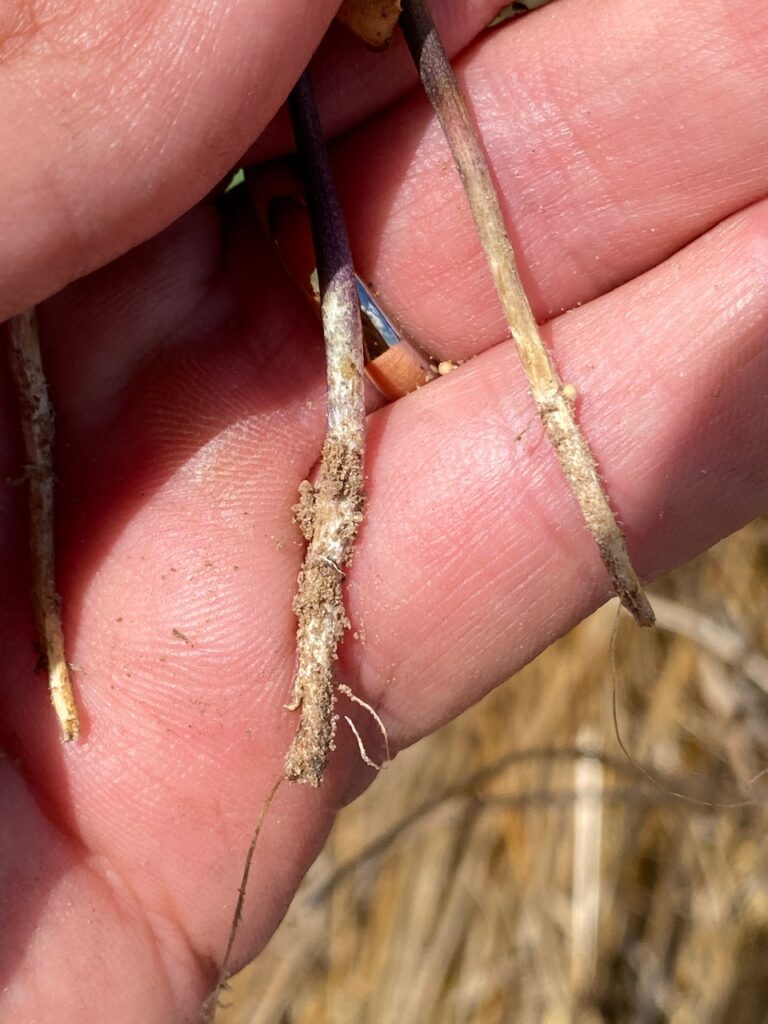Looks like rain this weekend. There has been a decent amount of planting going on earlier this week, although with the expected rains this weekend the past day or so has really slowed down. Appling County row crop farmers are hoping to get a decent rain shower this weekend to provide some soil moisture to carry us on into prime time planting season in mid-May. Checking out peanut fields this week I have not seen a field with a bad stand, seeing fields with anywhere from 3.8 to 4.5 seed/ft. If you would like any of your fields checked for stand counts give the Appling County Extension Office a call. The Appling County/ Bacon County Variety trial was planted last Friday, May 2nd, 2025. Special thanks to Ryne Powers and Jamie Williams for their cooperation with this peanut variety trial. Also, a special thanks to Southeastern Gin and Peanut and Nutrien Ag Solutions in Baxley, GA for donating seed to make this trial possible.
Topics in this Newsletter Include:
- Weather Forecast
- Southern Corn Rust Map
- Row Crop Disease Update – Dr. Bob Kemerait, UGA Plant Pathologist
- Irrigation Uniformity and Irrigation Guides – Dr. Wes Porter, UGA Precision AG Specialist
- Recent Preventable Problems and Valor Injury Likely, Again – Dr. Eric Prostko, UGA Weed Scientist
- UGA Peanut Team and UGA Cotton Team Podcast
- May Cotton Team Newsletter – UGA Cotton Team
Weather Forecast

Southern Corn Rust Map
This week Appling County ANR scouted several corn fields on the hunt for Southern Rust in the most mature corn fields of Appling County (V10+). Leaves were collected and sent to tifton to be checked for Southern Corn Rust as well. There was no Southern Corn Rust detected and this scout for rust will occur weekly by Appling County ANR and leaves will be sent to Dr. Kemerait in Tifton as part pf a collaboration with the Crop Protection Network. If you come across any suspicious leaves be sure to give the Appling County Extension Office a call. You can keep up with if your county has been scouted for southern rust or if any has been detected by checking the site in the link below.

Row Crop Disease Update – Kemerait
Common Rust of Corn

Note the cinnnamon-brown pustules on the top of the leaves .This is common corn rust (Puccinia sorghii) that is NOT a threat to our corn. It can be differentiated from the potentially devastating southern corn rust (Puccinia polysora) because a) common rust pustules are dark cinnamon color (as opposed to yellow-orange), b) common rust pustules occur on the upper AND lower sides of the leaf, and c) when looking at spores through a microscope spores of P. sorghii are fish-eye shaped while P. polysora spores are more oval and lack a thickened wall. Common rust usually occurs much earlier in the season than does southern rust. When I get pictures and questions about common corn rust, WHY is this SO important? It is HUGELY important because it means folks are out there hunting for southern corn rust!! Early detection of common rust is important because it means we are likely to catch southern rust early as well.
Aspergillus Crown Rot of Peanut


It has been a while since I’ve seen better-than-even rain chances stretched over several days. Growers here certainly need the rain. In my world of diseases and nematodes, cooler temperatures and rain will do at least two things. 1) cooler, moist soils reduce the threat from Aspergillus crown rot on peanuts. Aspergillus crown rot (pictures from previous growing seasons attached images 2,3,4 ) is most likely problematic on saved seed, on seed with inadequate seed treatments, or when conditions are very hot and dry early in the season. The hot soil scalds the tender tissue near the crown of the plant, allowing disease to occur. Steps to manage this disease include 1) planting high quality seed with effective seed treatment, 2) use of fluopyram (Velum or Propulse) infurrow when risk is high, 3) timely irrigation to cool soils, and 4) management of lesser corn stalk borers.
Thimet Burn and Tomato Spotted Wilt Virus in Peanut


The first picture shows very common symptoms of leaf margin burn and spotting on young peanut leaves. What is causing this? Exactly! This is NOT disease; it is “Thimet burn” after Thimet was used in-furrow to manage thrips and reduce risk to Tomato spotted wilt disease. These symptoms should simply reassure growers that the Thimet has activated natural defenses in the peanut plant that fight the disease. The second picture is another common early season disease- this is tomato spotted wilt on peanut. What can be done about it now? That’s right, nothing. All management options (other than avoiding use of Classic herbicide) end when the furrow is closed (Peanut Rx).
Southern blight/white mold caused by Sclerotium rolfsii of Soybean


Pics above are from Cale Yarbrough they tell a story of soybeans planted after peanuts in Grady Co. I would have guessed Rhizoc, but Cale schooled me with the pictures. In fact, these pictures tell the story of southern blight/white mold caused by Sclerotium rolfsii. Maybe the first time I have seen this disease (which is hugely important on our peanut crop) affect seedling soybeans. This means the environment is RIGHT for spread of white mold (warm early season) and that growers need to be Boy Scouts and be prepared.
Ext. PA and Irrigation Blog Post on Irrigation Uniformity – Dr. Wes Porter
It’s that day of the week again when we post the week Extension Precision Ag and Irrigation Blog Post. This week we opted to do an update and reminder on Pivot Uniformity. While it’s most likely too late in the season, it’s good to monitor and think about this topic. Especially with how dry it has been around and the potential for more dry weather. There is a section about some components to check and fix immediately.
Are You Sure Your Pivot is Operating at Peak Efficiency? | Extension Precision Ag and Irrigation
Also, see the link below for the Irrigation Quick Reference Guide for Cotton, Peanuts, Corn, and Soybeans
https://extension.uga.edu/publications/detail.html?number=C1189
Recent Preventable Problems – Prostko
Here are a few pictures of recent weed science related problems. Both could have been avoided by reading and following the label. Label recommendations are NOT suggestions.
1) Problem: Reflex 2SL (fomesafen) applied to snapbean in the fall (2024) with field corn planted this spring (2025). What does label the label say? Crop rotation restriction for field corn after Reflex is 10 months.

2) Problem: Clarifier 4SL (dicamba) @ 8 oz/A applied 3 days before planting soybeans not tolerant to dicamba. What does the label say? Following applications of Clarifier and a minimum accumulation of 1″ rainfall or overhead irrigation, a waiting interval of 14 days is required for 8 fluid ounces per acre or less, and 28 days for 16 fluid ounces per acre.

Valor Injury Likely (Again) – Prostko
Valor (flumioxazin) was first registered for use in peanut in 2001. Since that time, we have observed injury symptoms EVERY year across the state. Thus, it should no longer be a shock or surprise to anyone when it happens. The current predicted rainfall events over the next few days will likely result in Valor injury in some peanut fields, particularly in fields where peanuts are cracking. I do not feel the need to reinvent the wheel, so please check out the following blog post from last year where I have addressed the Valor/peanut injury issue:
Saturday, May 13, 2023
Valor/Peanut Injury (Again) – Prostko
Last night (May 12), many areas of the state received some rainfall. In some locations, it was more than 1″ (Camilla = 1.47″; Ft. Valley = 2.04″; Midville = 2.67″, TyTy = 3.14″). Thus, I am pretty sure that my phone will be ringing off the hook this week about Valor injury in peanuts. I have discussed this problem many times before in this blog (June 3, 2013; May 4, 2017; May 21, 2020) so check those other posts out. A few things to remember: 1) This is not a new problem. Valor injury has occurred somewhere in GA since it was first registered way back in 2001; and 2) History and lots of data suggest that most peanut fields suffering from Valor damage will recover without yield losses. Here are some pics and data to help you advise your growers not to panic. Note in the graphs that these plots received more than 8″ of rainfall/irrigation within the first 30 DAP and no yield losses were observed even at the 6 oz/A rate. But, I NEVER want any peanut grower to apply a 2X rate Valor on purpose though!



**TAKE HOME POINT FOR THE VALOR/PEANUT INJURY ISSUE: VALOR INJURY IS LIKELY BUT YIELD LOSS IN NOT!
UGA Peanut Team and UGA Cotton Team Podcast
Don’t forget to stay up to date with what’s going on in cotton and peanuts by listening to these UGA podcast.
EPISODE 10, Season 3
In this episode, Drs. Scott Monfort, Mark Abney, Wes Porter, Scott Tubbs, Bob Kemerait, and Tim Brenneman discussed planting issues along with disease and insect management. If you have any questions or would like to suggest topics for discussion on a future episode, contact your local UGA Extension agent. Go to All About the Pod News for supplemental information referred to during the podcast at: Season 3, Episode 10 | All About the Pod News
EPISODE 11, Season 3
In this episode, Drs. Scott Monfort, Mark Abney, Albert Culbreath, Scott Tubbs, Bob Kemerait, and Eric Prostko discussed planting issues related to seed quality, herbicides, fungicides, insecticides, and the potential weather pattern over the weekend. If you have any questions or would like to suggest topics for discussion on a future episode, contact your local UGA Extension agent.
Below is a link to Season 2, Episode 10 of the Talkin’ Cotton Podcast discussing current questions the cotton team is getting. Feel free to distribute far and wide. It will be posted on the UGA Cotton Team website on Monday. Remember, the link below will take you to buzzsprout, but the podcast is available on Apple Podcasts, Spotify, and Amazon Music. Y’all have a good weekend!
May Cotton Team Newsletter – UGA Cotton Team